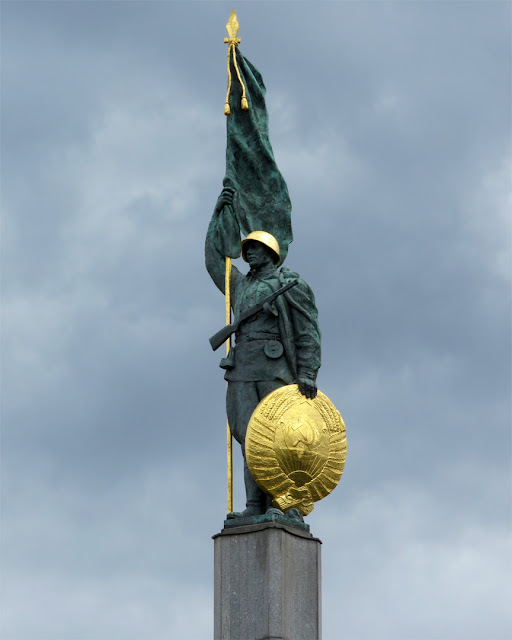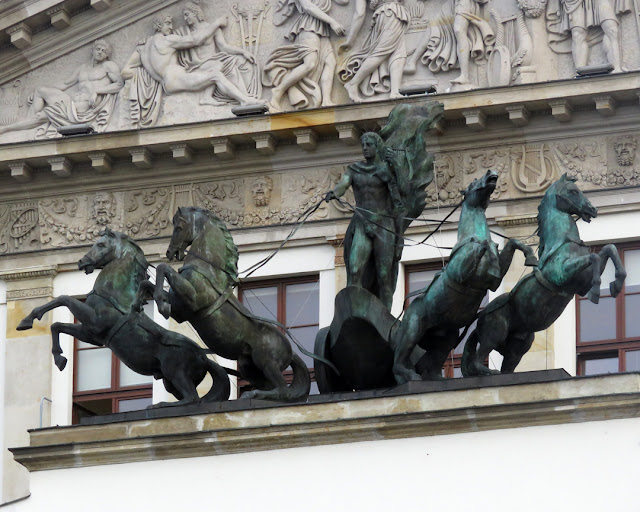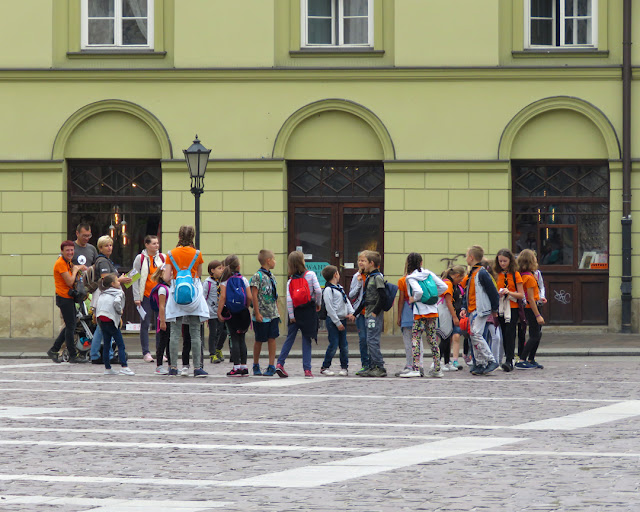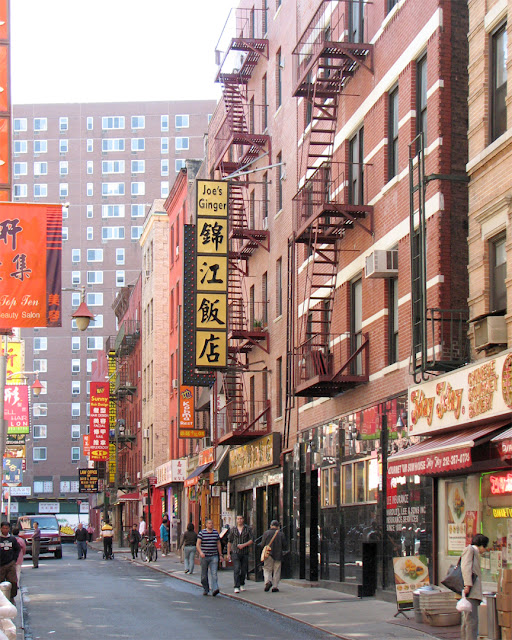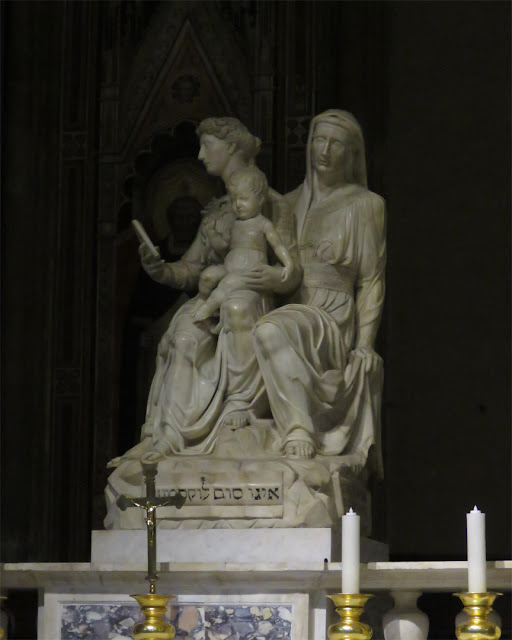Sunday, May 31, 2020
Soviet War Memorial
Soviet War Memorial by S.G. Yakovlev, 1945
Heldendenkmal der Roten Armee (Heroes' Monument of the Red Army)
Schwarzenbergplatz
Vienna, June 2018
Saturday, May 30, 2020
Arnolfo di Cambio
Arnolfo di Cambio by Luigi Pampaloni, 1830
Piazza del Duomo
Florence, December 2019
“Santa Maria del Fiore was built on the site of Florence's second cathedral dedicated to Saint Reparata; the first was the Basilica di San Lorenzo di Firenze, the first building of which was consecrated as a church in 393 by St. Ambrose of Milan. The ancient structure, founded in the early 5th century and having undergone many repairs, was crumbling with age, according to the 14th-century Nuova Cronica of Giovanni Villani, and was no longer large enough to serve the growing population of the city. Other major Tuscan cities had undertaken ambitious reconstructions of their cathedrals during the Late Medieval period, such as Pisa and particularly Siena where the enormous proposed extensions were never completed. City council approved the design of Arnolfo di Cambio for the new church in 1294. Di Cambio was also architect of the church of Santa Croce and the Palazzo Vecchio. He designed three wide naves ending under the octagonal dome, with the middle nave covering the area of Santa Reparata. The first stone was laid on 9 September 1296, by Cardinal Valeriana, the first papal legate ever sent to Florence. The building of this vast project was to last 140 years; Arnolfo's plan for the eastern end, although maintained in concept, was greatly expanded in size.” (Florence Cathedral, Wikipedia)
Friday, May 29, 2020
Firehouse, Engine Company 31
Firehouse, Engine Company 31
Lafayette Street
New York, September 2007
“Firehouse, Engine Company 31 is a historic fire station located at 87 Lafayette Street between Walker and White Streets in the Civic Center neighborhood of Manhattan, New York City. It was built in 1895 and designed by architects Napoleon LeBrun & Sons, who built it in the style of chateau in the Loire Valley of France from the early 16th-century. The building was designated a New York City Landmark in 1966 and added to the National Register of Historic Places in 1972. The fire department vacated the building in November 1972, and it is currently occupied by the Downtown Community Television Center (DCTV).” (Firehouse, Engine Company 31, Wikipedia)
Thursday, May 28, 2020
Guillaume Apollinaire
Grave of Guillaume Apollinaire (1880-1918)
Cimetière du Père-Lachaise, (Père Lachaise Cemetery)
Quartier du Père-Lachaise, 20th arrondissement
Paris, July 2014
Wednesday, May 27, 2020
The Myth of Rome
“The Myth of Rome” by Ferruccio Ferrazzi, 1938
Former INPS buildings
Piazza Augusto Imperatore
Rome, September 2019
Tuesday, May 26, 2020
Open air amphitheater
Open air amphitheater
Gulbenkian Park
Avenida de Berna
Lisbon, April 2019
“A beautiful open air venue, in the middle of the garden, that holds shows during spring and summer. It's also an excellent place to stop, read or rest. The amphiteatre stage holds events from theatre to cinema and concerts during the months of June and July. The first two weeks of August, the Jazz em Agosto Festival takes place for over 30 years.” (Open air amphitheater, Calouste Gulbenkian Foundation)
Monday, May 25, 2020
Sunday, May 24, 2020
Filippo Brunelleschi
Filippo Brunelleschi by Luigi Pampaloni, 1830
Piazza del Duomo
Florence
Florence, December 2019
“A circular masonry dome can be built without supports, called centering, because each course of bricks is a horizontal arch that resists compression. In Florence, the octagonal inner dome was thick enough for an imaginary circle to be embedded in it at each level, a feature that would hold the dome up eventually, but could not hold the bricks in place while the mortar was still wet. Brunelleschi used a herringbone brick pattern to transfer the weight of the freshly laid bricks to the nearest vertical ribs of the non-circular dome. The outer dome was not thick enough to contain embedded horizontal circles, being only 60 centimetres (2 ft) thick at the base and 30 centimetres (1 ft) thick at the top. To create such circles, Brunelleschi thickened the outer dome at the inside of its corners at nine different elevations, creating nine masonry rings, which can be observed today from the space between the two domes. To counteract hoop stress, the outer dome relies entirely on its attachment to the inner dome and has no embedded chains.” (Florence Cathedral, Wikipedia)
Saturday, May 23, 2020
Stephen the lion
Stephen the lion of HSBC Bank
Bowery
Chinatown, Lower Manhattan
New York, September 2007
“Various headquarters and branch buildings of The Hongkong and Shanghai Banking Corporation (and later the HSBC Group) feature a pair of lion sculptures. The HSBC lions have become distinctive landmarks in their own right in Hong Kong and Shanghai, with a further pair to be found in London. The first set of lion sculptures were commissioned for the rebuilt HSBC Building on the Bund in Shanghai, opened in 1923. Chief Manager Alexander Stephen wrote, in 1921, that the inspiration for his decision to order their sculpting came from the imposing lions outside the Venetian Arsenal. Cast by J W Singer & Sons in the English town of Frome, to a design by Henry Poole RA, these lions had quickly become part of the Shanghai scene, and passers-by would affectionately stroke the lions in the belief that power and money would rub off on them. They became known as Stephen and Stitt. Stephen was named for Alexander Gordon Stephen, formerly Manager Shanghai, and in 1923 the Chief Manager of HSBC, and Gordon Holmes Stitt, the then Manager Shanghai. Stephen is depicted roaring, Stitt quiescent; insiders said that this represented the characters of the two famous bankers.” (HSBC lions, Wikipedia)
Friday, May 22, 2020
Kwadryga Apollina
Kwadryga Apollina (Apollo's quadriga) by Adam Myjak and Antoni Janusz Pastwa, 2002
Teatr Wielki w Warszawie (Grand Theatre in Warsaw)
plac Teatralny
Warsaw, September 2018
“According to Antonio Corazzi's 1825 plans, the Grand Theatre's front façade was meant to feature a triumphal sculpture of Apollo, patron of the arts, driving a chariot drawn by four horses. However, the defeat of the November Uprising caused the idea to be abandoned. The platform above the main entrance meant for the quadriga remained empty for nearly 200 years. Finally, in 2002, at the initiative of the Grand Theatre's then-general director, Waldemar Dąbrowski, the sculpture that had been envisioned many years earlier came to adorn the façade. The new, contemporary quadriga was designed by professors at the Warsaw Academy of Fine Arts, the rector, Adam Myjak, and the dean of the sculpture department, Antoni Janusz Pastwa. The sculpture was unveiled by Polish President Aleksander Kwaśniewski on May 3, 2002, to mark Constitution Day.” (Grand Theatre, Wikipedia)
Thursday, May 21, 2020
Santa Maria della Concezione
Santa Maria della Concezione in Campo Marzio
(Seen from Via della Maddalena)
Piazza in Campo Marzio
Rome, September 2019
“In the 17th century the convent was enlarged and re-ordered by Carlo Maderno and Francesco Peparelli, with work completed by 1660. The 16th century church was completely rebuilt according to the wishes of abbess Maria Olimpia Pani, to plans by Giovanni Antonio De Rossi. During excavations in 1777 as part of expanding the convent a column was discovered - this was re-erected in 1856 in the piazza di Spagna as the base for a statue of the Virgin of the Immaculate Conception, in commemoration of that belief being proclaimed a dogma by pope Pius IX. During the Napoleonic occupation of Rome the church was deconsecrated and used as a lottery office. It reopened to the public in 1816 and now holds services according to the Syrian-Antioch rite, as the national church for Syria and the seat of the procurator to the Holy See for the Syrian Catholic Patriarchate of Antioch.” (Santa Maria della Concezione in Campo Marzio, Wikipedia)
Wednesday, May 20, 2020
Tuesday, May 19, 2020
Monday, May 18, 2020
Arte di Calimala
The eagle on a bolt of cloth, symbol of the Arte di Calimala
Piazza di San Giovanni
Florence
Florence, December 2019
“The Arte di Calimala, the guild of the cloth finishers and merchants in foreign cloth, was one of the greater guilds of Florence, the Arti Maggiori, who arrogated to themselves the civic power of the Republic of Florence during the Late Middle Ages. The ascendancy of the Calimala ran from the organization of Florentine guilds, each with its gonfaloniere in the thirteenth century, until the rise of the Medici usurped all other communal powers in the fifteenth century. Their presence is commemorated in the via di Calimala, leading away from the city's Roman forum (now Piazza della Republica) through the Mercato Nuovo to the former city gate, the Por Santa Maria, as the Roman cardo; the main street, as old as Florence itself, was a prime location for trade, even though, unpaved, crowded, and much narrower than its present state, it was truly a callis malis, an ‘ill passage-way’. The name Calimala is of great antiquity and obscure etymology. Though the original earliest archives of the Arte di Calimala were lost in an 18th-century fire, abundant copies, preserved at the Archivio di Stato, Florence, document the guild's statutes and its activities.” (Arte di Calimala, Wikipedia)
Sunday, May 17, 2020
Saturday, May 16, 2020
Marcel Proust
Grave of Marcel Proust (1871-1922)
Cimetière du Père-Lachaise, (Père Lachaise Cemetery)
Quartier du Père-Lachaise, 20th arrondissement
Paris, July 2014
Friday, May 15, 2020
Museum of the Ara Pacis
Museum of the Ara Pacis
Lungotevere in Augusta
Rome, September 2019
“The Museum of the Ara Pacis (Museo dell'Ara Pacis) belongs to the Sistema dei Musei in Comune of Rome; it houses the Ara Pacis of Augustus, an ancient monument that was initially inaugurated on January 30, 9 B.C. Designed by the American architect Richard Meier and built in steel, travertine, glass and plaster, the museum is the first great architectural and urban intervention in the historic centre of Rome since the Fascist era. It is a structure with a triumphal nature, clearly alluding to the style of imperial Rome. Wide glazed surfaces allow the viewer to admire the Ara Pacis with uniform lighting conditions. The white colour is the trademark of Richard Meier, while the travertine plates decorating part of the building are a consequence of in-progress changes (aluminum surfaces were initially planned), after a design review following controversies with some nostalgia for the previous pavilion that was built in 1938 by the architect Vittorio Ballio Morpurgo. The challenging design of Meier wants to assert itself in the very hearth of the town, becoming a nerve and transit centre. The complex was intended to include a crosswalk with an underpass linking the museum to the Tiber river; presently the underpass design seems to have been abandoned completely.” (Museum of the Ara Pacis, Wikipedia)
Thursday, May 14, 2020
Ascensor da Glória
Ascensor da Glória (Glória Funicular)
Miradouro de São Pedro de Alcântara
Bairro Alto
Lisbon, April 2019
Wednesday, May 13, 2020
Tuesday, May 12, 2020
Virgin and Child with Saint Anne
‘Virgin and Child with Saint Anne’ by Francesco da Sangallo, 1526
Orsanmichele
Via dell'Arte della Lana
Florence, December 2019
“Finally we cast a glance at the altar on the other side. Here we see a statue, Virgin and Child with Saint Anne, by Francesco da Sangallo. This statue is quite special in one respect: it has been cut out of one marble block and that is no easy feat. Michelangelo also discovered this when he carved four figures out of one block. This failed miserably and out of anger he smashed his Pietà, which we have seen in the Museo dell Opera del Duomo, to pieces. In view of the chronological development of sculpture in this story, the Virgin and Child with Saint Anne will be discussed later, with Michelangelo. Buonarroti encountered the limits of carving multiple figures out of one block.” (Orsanmichele and its statues, Ruud Taggelaar)
Monday, May 11, 2020
Peace Fountain
Detail of the Peace Fountain by Greg Wyatt, 1985
Cathedral of Saint John the Divine
Amsterdam Avenue, Morningside Heights
New York, September 2007
“The Peace Fountain is a 40-foot-high (12 m) sculpture and fountain located next to the Cathedral of St. John the Divine in the Morningside Heights section of Manhattan in New York City. It was commissioned in 1985 by Greg Wyatt, sculptor-in-residence at the cathedral. The sculpture depicts the struggle of good and evil, as well as a battle between the Archangel Michael and Satan. The sculpture also contains the Sun, the Moon, and several animals. Although it is called a fountain, there is currently no water on the site.” (Peace Fountain, Wikipedia)
Sunday, May 10, 2020
Plaça del Sol
Sundial by Joaquim Camps
Plaça del Sol
Vila de Gràcia
Barcelona, March 2017
“If we enter the neighborhood of Gràcia we will discover two very curious sundials. There is a sundial in Plaza del Sol, of course. It is an empty hemisphere, made of bronze, encircled by the twelve signs of the zodiac, in which the time lines are recorded. Astrolabe, he's called. The author is Joaquim Camps, who also made the sculpture of Rovira and Trias located in Plaça Rovira. The highlight of the neighborhood is the one on the facade of the ‘Lluïsos de Gràcia’ (Plaça del Nord), a cultural entity of great tradition, founded in 1855; this is a watch of painted sun and a rectangle of four meters wide, with two angels on both sides that hold it imaginatively. It was designed in 1990 by two brothers, Jordi and Josep Nogué.” (Barcelona: Watch clocks, El sol i el temps)
Saturday, May 9, 2020
Our Lady of Victory
“The Virgin Mary Triumphing over Heresy” and “Fall of the Rebel Angels” by Giovanni Domenico Cerrini
Vault of Santa Maria della Vittoria (Our Lady of Victory)
Via Venti Settembre
Rome, June 2019
Friday, May 8, 2020
Foggy day on the Tagus
A foggy day on the Tagus
Sanctuary of Christ the King
25 de Abril Bridge
Lisbon, April 2019
“After forming the border it enters Portugal, passing Vila Velha de Ródão, Abrantes, Constância, Entroncamento, Santarém and Vila Franca de Xira at the head of the long narrow estuary, which has Lisbon at its mouth. The estuary is protected by the Tagus Estuary Natural Reserve.” (Tagus, Wikipedia)
Thursday, May 7, 2020
Trzy Gracje
“Trzy Gracje” (Three Graces) by Krzysztof Bednarski
Bohaterów Monte Cassino
Sopot, September 2018
“Krzysztof Michał Bednarski (KMB) (25 July 1953 in Kraków) is a contemporary Polish-Italian sculptor. He was one of three sons of Irena and Jerzy Bednarski. Before the war, his parents lived in Lwów on Kulparkowska Street. Bednarski completed the XIV High School of General Gottwald in Warsaw. Later he graduated from the Academy of Fine Arts in Warsaw (1973-1978) in the sculpture department in the studios of Jerzy Jarnuszkiewicz and Oskar Nikolai Hansen.” (Krzysztof Bednarski, Wikipedia)
Wednesday, May 6, 2020
Marble statues
Marble statues
Loggia dei Lanzi
Piazza della Signoria
Florence, December 2019
“On the back of the Loggia are five marble female statues (three are identified as Matidia, Marciana and Agrippina Minor) Sabines and a statue of a barbarian prisoner Thusnelda from Roman times from the era of Trajan to Hadrian. They were discovered in Rome in 1541. The statues had been in the Medici villa at Rome since 1584 and were brought here by Pietro Leopoldo in 1789. They all have significant, modern restorations.” (Loggia dei Lanzi, Wikipedia)
Tuesday, May 5, 2020
Puck Building
Puck Building
Mulberry Street
New York, September 2007
“During Little Italy's annual Feast of San Gennaro, which takes place on Mulberry Street, strings of lights are strung from the building's Mulberry Street walls.” (Puck Building, Wikipedia)
Monday, May 4, 2020
Velocipede
Velocipede outside Lapidarium
Nowomiejska
Stare Miasto (Old Town)
Warsaw, September 2018
“A velocipede is a human-powered land vehicle with one or more wheels. The most common type of velocipede today is the bicycle. The term was probably first coined by Karl von Drais in French as vélocipède for the French translation of his advertising leaflet for his version of the Laufmaschine, also now called a ‘dandy horse’, which he had developed in 1817. It is ultimately derived from the Latin velox, veloc- ‘swift’ + pes, ped- ‘foot’. The term ‘velocipede’ is today mainly used as a collective term for the different forerunners of the monowheel, the unicycle, the bicycle, the dicycle, the tricycle and the quadracycle developed between 1817 and 1880. It refers especially to the forerunner of the modern bicycle that was propelled, like a modern tricycle, by cranks, i.e. pedals, attached to the front axle before the invention of geared chains and belt and shaft drives powering the rear.” (Velocipede, Wikipedia)
Sunday, May 3, 2020
The Dome of Sant'Ivo
Sant'Ivo alla Sapienza
Corso del Rinascimento
Rome, September 2019
“The interior of Sant'Ivo is unique because of the shapes incorporated into the rotunda. Borromini was well known for fusing of geometrical shapes as well as his pairing of columns in order to facilitate curves, incorporating them in an harmonious manner in his project at San Carlino. But for Sant'Ivo, Borromini did not blend the different shapes. The rotunda of Sant'Ivo is contrived of distinct shapes, a triangle with its three angles cut as if bitten off, and semi-circles located in between the triangle’s three lines. Despite the shift from the smooth geometrical alignments of San Carlino to the sharper abrupt geometrical bends in Sant'Ivo, both buildings exhibit harmony between the sharp edges and the curves and spheres. Borromini utilized curves (semi-circles) and edges (clipped triangle tips) in equal amounts to define the shape of the rotunda. This blending of edges and curves is arguably Borromini’s most distinguishable signature.” (Sant'Ivo alla Sapienza, Wikipedia)
Saturday, May 2, 2020
Castelo de São Jorge
Castelo de São Jorge (São Jorge Castle)
Rua de Santa Cruz do Castelo
Lisbon, April 2019
“São Jorge Castle (Castelo de São Jorge) is a historic castle in the Portuguese capital of Lisbon, located in the freguesia of Santa Maria Maior. Human occupation of the castle hill dates to at least the 8th century BC while the first fortifications built date from the 1st century BC. The hill on which São Jorge Castle stands has played an important part in the history of Lisbon, having served as the location of fortifications occupied successively by Phoenicians, Carthaginians, Romans, and Moors, before its conquest by the Portuguese in the 1147 Siege of Lisbon. Since the 12th century, the castle has variously served as a royal palace, a military barracks, home of the Torre do Tombo National Archive, and now as a national monument and museum.” (São Jorge Castle, Wikipedia)
Friday, May 1, 2020
Kościół św. Barbary
Kościół św. Barbary (Church of St. Barbara)
Mały Rynek
Stare Miasto (Old Town)
Kraków, September 2018
Subscribe to:
Posts (Atom)

